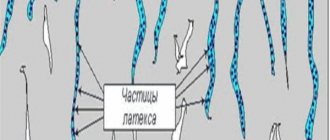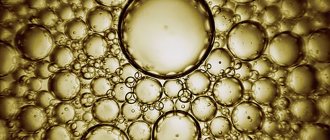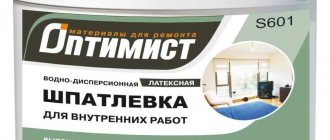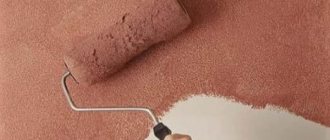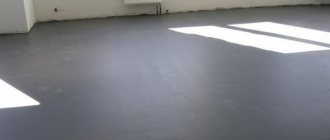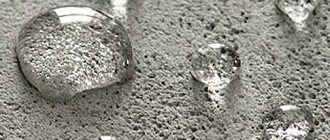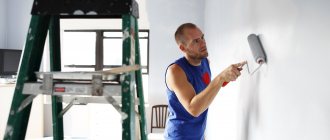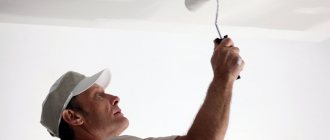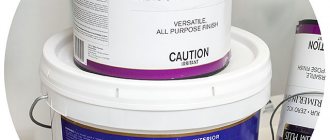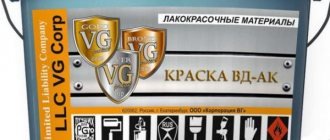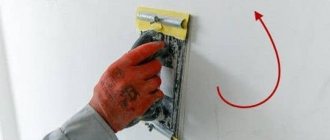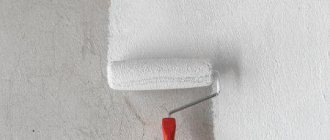Andrey
4194 0 2
Andrey June 26, 2017 Specialization: facade finishing, interior finishing, construction of dachas, garages. Experience of an amateur gardener and gardener. We also have experience in repairing cars and motorcycles. Hobbies: playing the guitar and many other things that I don’t have time for :)
Water-based primer (water-dispersion) - what kind of material is it and what is it used for? I will talk about all the technical parameters and share my experience in applying primer, which will certainly help beginners avoid mistakes when working with this coating.
Water-dispersed soil performs a number of functions, including improving adhesion and strengthening the base
general description
Water-dispersion primer is made on the basis of water. Structurally, it is a dispersion of polymer acrylates in water. A dispersion is a mixture of small particles that are found in water in an undissolved form. When the water evaporates, only these particles remain on the surface and polymerization occurs. As a result, a film of small thickness is formed on the surface.
Conclusion
Now you know what water-dispersed soils are, what they should be according to GOST and what they are used for. Before using this material, watch the video in this article. If I missed any points that interest you, write in the comments and we will discuss them.
Priming is an integral stage of repair work. Today, stricter requirements are imposed on the primer: it must meet not only a physical and mechanical set of parameters, but also environmental friendliness. The characteristics of the water-dispersion primer speak for themselves: it is made without the use of harmful solvents, which is why it has earned its recognition not only among home craftsmen, but also among specialists.
Advantages and disadvantages
The main advantage of such a primer is that it is absolutely harmless. Unlike products that contain chemical solvents, water-dispersion primer does not produce an unpleasant odor when used. However, the person doing the priming needs to be careful not to get the product in the eyes. When using this primer, windows and doors do not need to be opened.
The water-dispersion primer is easy to use and non-flammable. It is applied to wall surfaces using a roller or brush. Priming with this product is quick, even if you need to coat 2 layers.
There are almost no disadvantages to such a primer. A minor disadvantage is the need to store the product at a positive temperature. When frozen, the primer loses its properties.
Application of the primer should be carried out at temperatures above 5 degrees and at air humidity of no more than 80 percent. Otherwise, a film simply does not form on the surface.
Universal formulations
Primers of this type are in most cases used for pre-treatment of plastered, brick or plasterboard surfaces.
Products of this type can improve the adhesion of all materials and at the same time strengthen them. Also, such primers have antiseptic properties. That is, for example, fungus does not form on surfaces when they are subsequently used. Accordingly, the walls themselves, treated with this composition before painting, can last as long as possible.
Technical characteristics of water-dispersion primer
The water-dispersion primer has the following technical characteristics:
- appearance – uniform film, without pores, cracks, pits;
- mass fraction of non-volatile elements – not less than 28 percent;
- conditional viscosity – not less than 14 s;
- grinding level – no more than 70 microns;
- washability of the formed film is no more than 3.5 g per cubic meter. m;
- resistance to the static action of an aqueous environment - no more than 24 hours;
- drying time to degree 3 – no more than 14 hours.
Adhesive agents
Primers of this group are used to treat very smooth surfaces. This could be, for example, concrete or plastic. They can also be used for ceramics, glass, and painted materials.
The water-dispersion primer “Concrete Contact”, which is very popular among plasterers, painters and home craftsmen, belongs to this type. Products of this type can significantly increase the adhesive properties of smooth surfaces. The paint on such materials subsequently lays down in an even layer and lasts for a very long time.
Purpose of water-dispersion primer
The primer is intended to:
- Strengthen the main building material. This is especially important for surfaces that crumble or crumble.
- Increase adhesion. Using a water-dispersive agent, you can prevent the material from falling off, sticking and other deformations after completion of repair work.
- Increase moisture resistance. High levels of humidity are typical for basements and bathrooms.
- Reduce the number of pores in the surface. Thanks to this, the costs of putty, paint, and plaster are reduced.
- Create a protective antiseptic layer. This prevents the growth of fungal organisms and mold.
- Prevent corrosion. Corrosion may begin if the surface is made of metal.
- Make painting easier. The paint is applied evenly and uniformly to the primed base.
- Extend the service life of the decorative coating and its wear resistance.
Areas of application
One of the undoubted advantages of water-dispersible products is their versatility. According to regulations, the following surfaces are allowed to be coated with such compounds before painting:
- mineral - concrete, blocks, brick, plasters;
- wood, OSB, chipboard, etc.;
- GKL;
- metal;
- plastic.
Such products are very widely used for all these surfaces. At the same time, the preparation of such materials before painting using water-dispersed agents is very high quality.
Technology of use
The algorithm for using a primer looks like this:
- Prepare the surface. The substrate to which the product will be applied must be dry and clean and free of peeling coatings. If you plan to treat a metal surface, remove all rust from it.
- Prepare the primer. Shake the container with the product. If the primer is too viscous, pour some water into it.
- Apply primer to the surface. The product must be applied in a thin layer.
Purpose
Water-dispersed primer can be applied to almost any surface, such as:
- Mineral bases (concrete, brick, plasters, putties, etc.);
- Wood and wood-based materials;
- Metal;
- Plastic;
- Drywall, etc.
Of course, soils with different properties are used for different surfaces. Depending on this, this material is divided into the following types:
Types of water-dispersed soils
Next, I became more familiar with all types of primers.
Types of water-dispersion primer
Today there are 10 different types of water-dispersion primer, each of which has its own characteristics. In addition, there are 4 types of primers, which differ in their purpose:
- Adhesive. Designed to increase the strength of adhesion between several layers of finishing and the surface being treated. Can be used to strengthen layers when painting, zinc coating, or plaster.
- Insulating. Contain elements characterized by viscosity and stickiness (oil liquids, adhesives, resins, pigment components).
- Strengthening. They are used for the initial treatment of the base to strengthen and level it before finishing. This category includes deep-penetrating agents. Their distinctive feature is considered to be fine-grained binding elements, which ensure surface impregnation to a depth of 100 mm and filling of all microscopic cracks.
- Anti-corrosion. Designed for treating metal surfaces and protecting them from rust.
Universal
The universal primer promotes:
- improving adhesive properties;
- strengthening the foundation;
- the formation of a film that reduces the cost of finishing materials and allows them to dry evenly.
Such products are used to treat the following surfaces:
- plastered;
- plasterboard;
- brick.
Deep penetrating
A deep-penetrating primer has the ability to absorb into loose surfaces. After polymerization, it glues the pores together, which strengthens the base. It can be used to treat surfaces that have a large number of pores or crumble, for example:
- old surfaces covered with plaster;
- wood;
- cellular concrete.
In stores you can purchase products designed specifically for wood. They differ from others in that they protect the tree from pests and dampness.
Primer for water-dispersion paint
This type of primer is used to prepare the surface for treatment with water-dispersion paint. The latter is a finishing material often used for painting façade parts and indoor surfaces. It is also distinguished by its reliability, durability, and environmental friendliness.
Water-dispersion primer for concrete
Primers for concrete include acrylic and polyurethane. It is used to reduce the cost of finishing coating on a concrete surface. The primer averages color values over the entire area of the treated base and ensures the removal of minor defects before painting. By using priming, you can significantly reduce paint costs and increase the service life of curtain walls and corrugated slate.
Acrylic water-dispersion primer
This primer includes polymer acrylic with various additives. Using it, you can create a reliable and high-strength adhesion to almost any material. Acrylic water-dispersion primer is used to treat the following substrates:
- concrete;
- wooden;
- plasterboard;
- glass;
- plastered;
- putty.
There is an opinion that water-dispersion primers should not be used for treating metal surfaces, as they will cause the metal to rust. A properly selected acrylic primer eliminates the development of corrosion and forms a layer on the metal surface that protects the base from moisture and precipitation.
Adhesive
This primer gives the treated surfaces increased adhesive properties. Used to treat the following surfaces:
- glass, ceramic;
- plastic;
- concrete;
- painted.
Anti-corrosion
This primer includes elements that protect the base from corrosive effects. Used for processing metal bases. It can be used for application on both ferrous and non-ferrous metals. Also, if necessary, an anti-corrosion primer can be used to treat putty substrates.
Water-dispersion alkyd primer
Used for application to surfaces with poor absorption. Alkyd primer dries quickly and provides good corrosion protection. It is optimal for processing such surfaces:
- plastic;
- glass;
- metal.
Note!
Alkyd products should not be used to treat plasterboard. This is due to the fact that the resins contained in the alkyd primer increase the hairiness of drywall.
Latex primers
Latex primers are superior in their own parameters to both alkyd and acrylic ones. They are more moisture- and frost-resistant when compared with the listed types of primers, and also have increased adhesive characteristics.
Latex primers can even be applied to substrates that have already been painted. There is no need to pre-prepare the surface or remove layers of paint from it.
Silicone primer
Silicone primers are used for painting facade parts, as well as when processing materials with a large number of pores. They have the following features:
- increased vapor permeability;
- high resistance to low temperatures;
- strengthening the foundation.
The cost of silicone products is quite high, but it is compensated by their characteristics. It is advisable to buy products from well-known manufacturers, which include the following companies:
- "Knauf". Occupies a leading position in the market for priming products. Particularly noteworthy is the Tiefengrund primer, which dries quickly and is colorless. It can be used for processing gypsum fiber boards and self-leveling floors.
- "Birss." Water-dispersion primer “Concrete Contact” is optimal for application on concrete surfaces of any type: foundations, floor and wall surfaces.
- "North". A Russian manufacturer that has been working on the market for 15 years. Among the products of this company, you can find very specific primers that other manufacturers do not have. For example, the water-dispersion primer “Nortex Soil Antiseptic” is economical, inexpensive, and universal in use. In addition, North produces a series of unique fire-bioprotective primers for wood.
- "Keresit". Well-known primers from this company: bitumen BT 29 WB, silicone CT 15, acrylic CT
- "Vetonit." A company from Europe, which has enterprises even in the CIS. The primer “MD 16”, intended for application to floor surfaces, and the universal product “Vetonit Dispersio” are in particular demand.
Types and characteristics
The composition and technical requirements of aqueous primers must meet the standards of GOST R 52020-2003.
Water primer gets its name from the use of water as the main diluent. That is why all types of compounds are environmentally friendly and safe.
Water-based primer has several classifications, distinguished by functions and compositions. Depending on the functions performed, soils are divided into several types:
- Adhesive primer. Its main purpose is to increase adhesion between the surface being treated and the finish.
- Strengthening, used for treating loose and old bases.
- A water-dispersion deep primer designed to fill all, even very deep, surface microcracks. The composition is capable of penetrating 10 cm deep.
- Insulating, forming a thin film designed to protect the base from external influences.
- Anti-corrosion primer used for treating metal surfaces to protect them from corrosion.
- Antiseptic, playing the role of a kind of protector of the bases from the proliferation of fungal spores.
- Universal, combining the properties of all of the above compounds.
The composition of the primer may vary according to the main structural element, which was the reason for the gradation:
Water-based acrylic primer
The main components contain acrylic polymers mixed with plasticizing and elasticizing additives. In turn, such soils are divided into the following subtypes:
- adhesive;
- deep penetration.
The scope of application is quite extensive, including painting concrete, plasterboard, wood, plastered, puttied, fiberglass surfaces, etc.
Water-dispersion alkyd primer
Despite the presence of alkyd resin in the composition, the solution is absolutely harmless to humans. Thanks to the aquatic environment of the soil, the harmful effects of alkyd substances are reduced.
The use of such primers is appropriate for treating poorly absorbent substrates (plastic, metal, tiles, glass, etc.).
Latex primers
They are rightly called ideal. Their technical parameters significantly exceed the properties of alkyd and even acrylic water-dispersed primers.
The latex film-forming agents included in the composition provide excellent moisture resistance. Their use is not limited to use only on prepared surfaces.
Silicone primer
Combines the qualities of latex and acrylic. Due to this, it is quite versatile and can be used on both porous and poorly absorbent surfaces.
Consumption of water-dispersion primer
60-180 g of water-dispersion primer is used per square meter of surface. A ten-liter canister of primer costs 400-800 rubles. Primer costs depend on the type of surface being treated, the number of pores and layers.
The use of water as a solvent gives the water-dispersion primer increased safety and environmental friendliness characteristics. When used, it does not irritate the mucous membranes and skin of workers and does not emit toxic elements. Therefore, it is an indispensable tool for repairs and decoration. The main thing is not to use it in low-temperature conditions, since, for example, in winter, a water-dispersion primer will not be very effective if work is carried out outdoors.
What varieties are there?
All currently produced water-dispersion primers are divided into three main types:
- polyvinyl acetate - the cheapest, do not tolerate high humidity;
- butadiene styrene - not too expensive, not afraid of moisture, but not particularly frost-resistant;
- acrylic - the most expensive, versatile, and can withstand low temperatures and high humidity.
It is the latter type of product that is most popular among plasterers and painters. Acrylic water-dispersion primers are, among other things, abrasion-resistant and elastic.
By area of use, products of this type are classified into:
- universal;
- adhesive;
- deep penetration;
- anti-corrosion.
Application of primer
The technology for applying the primer is not complicated. The rules are very simple, accessible even to those who have not yet had experience in repair and construction work. They are as follows:
- Prepare the base well:
- remove any remaining coating unless the manufacturer specifies that it can be applied over previous coats of paint. If necessary, use spatulas, a heat gun, a drill and other suitable tools;
- remove all construction debris, including dust from the surface;
- Rinse the base with water and wait until it dries completely.
- Make sure that the temperature outside or indoors is suitable - +5-+20 °C is considered optimal.
- Stir the primer solution until smooth. If you bought a ready-made mixture, also mix it a little.
- Pour into a convenient flat painting container.
- Dip a brush or roller into the mixture and coat the surface with a thin layer.
- Make sure that the primer is applied evenly - it is undesirable for smudges to remain.
- Apply paint strokes to all hard-to-reach joints and corners using a paint brush.
- Wait for it to dry.
- Apply 1-2 more layers.
Important! Experts recommend that 1 layer of primer is 1-2 mm. This is quite enough to get the desired result.
Anti-corrosion agents
Primers of this type contain substances that can prevent rusting. Water-dispersive agents of this group are used for treating metal surfaces. According to the regulations, they can be used for the preliminary preparation of any materials of this type. Both non-ferrous and ferrous metals can be treated with such primers.
If necessary, such products, of course, can be applied to other surfaces. For example, quite often plaster and putty are treated with anti-corrosion primers. The adhesive layer in this case is also very high quality.
